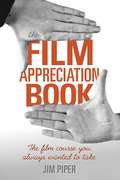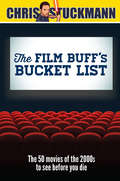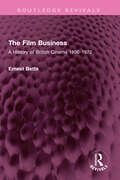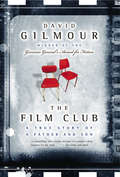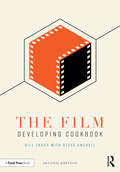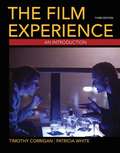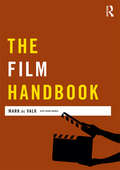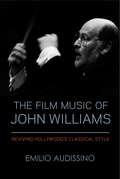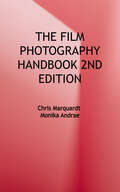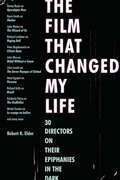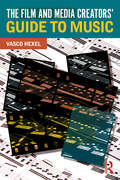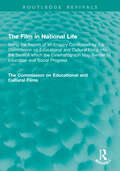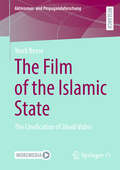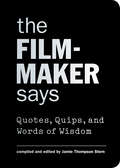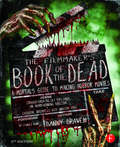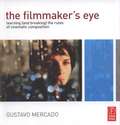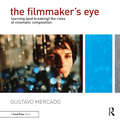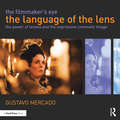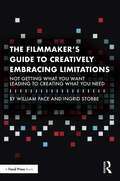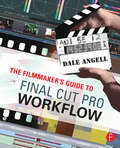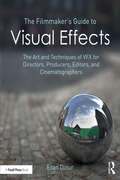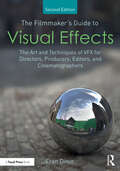- Table View
- List View
The Film Appreciation Book: The Film Course You Always Wanted to Take
by Jim PiperThis is a book for cinephiles, pure and simple. Author and filmmaker, Jim Piper, shares his vast knowledge of film and analyzes the most striking components of the best movies ever made. From directing to cinematography, from editing and music to symbolism and plot development, The Film Appreciation Book covers hundreds of the greatest works in cinema, combining history, technical knowledge, and the art of enjoyment to explain why some movies have become the most treasured and entertaining works ever available to the public, and why these movies continue to amaze viewers after decades of notoriety.Read about such classic cinematic masterpieces as Citizen Kane, Gandhi, Midnight Cowboy, Easy Rider, True Grit, Gone With the Wind, and The Wizard of Oz, as well as more recent accomplishments in feature films, such as Requiem for a Dream, Munich, The King's Speech, and The Hurt Locker.Piper breaks down his analysis for you and points out aspects of production that movie-lovers (even the devoted ones) would never recognize on their own. This book will endlessly fascinate, and by the time you get to the last chapter, you're ready to start all over again. In-depth analysis and thoughtful and wide-ranging film choices from every period of cinema history will ensure that you never tire of this reading companion to film.
The Film Buff's Bucket List: The 50 Movies of the 2000s to See Before You Die
by Chris StuckmannFrom the star YouTube reviewer, “a fantastic selection of movies, both big and small, that all film lovers can enjoy . . . a wonderful reference guide” (Alicia Malone, author Backwards and in Heels).Comic book heroes, ice princesses, apocalyptic lovestruck teens, whatever masterpiece Pixar is rolling out—not to mention countless indies and foreign films—there’s been no shortage of things to watch in recent years. But which films are the best of the best? What are the top twenty-first century movies to see before you die?Chris Stuckmann, one of YouTube’s most popular film reviewers with over 125 million views, gives us his best of the best in this list of the fifty very best movies since 2000—with all the style and punch his YouTube fans have come to love.“Chris Stuckmann is the Roger Ebert of Youtube and this book is awesome.” —Varla Ventura, author of Sheroes
The Film Business: A History of British Cinema 1896-1972 (Routledge Revivals)
by Ernest BettsFirst published in 1973 The Film Business makes a factual survey of British films from their beginnings in 1896 to 1972. Ernest Betts offers character studies of men who have built the film industry and made it what it is. He examines the financial and political background and shows how, while intending to encourage film production, it has often had exactly the opposite effect and inhibited its free development. Betts also attacks the manner in which the American film industry has taken over the British film industry and points to the failure of successive governments to save it from repeated crises and losses. Through these fluctuations the author keeps a firm eye on the film itself and brings the judgement of film critics past and present to bear on British cinema, as it moves uncertainly and not without its triumphs into the 1970s. This is an interesting read for students and scholars of film studies, British film history and British cinema.
The Film Club: A True Story of a Father and a Son
by David GilmourFrom the 2005 winner of the Governor-General’s Award for Fiction and the former national film critic for CBC television comes a delightful and absorbing book about the agonies and joys of home-schooling a beloved son. Written in the spare elegant style he is known for, The Film Club is the true story about David Gilmour’s decision to let his 15-year-old son drop out of high school on the condition that the boy agrees to watch three films a week with him. The book examines how those pivotal years changed both their lives. From French New Wave, Kurosawa, and New German cinema, to De Palma, film noir, Cronenberg and Billy Wilder, among many others from world cinema, we read about key moments in each film, as the author teaches his son about life and the vagaries of growing up through the power of the movies. Replete with page-turning descriptions of scenes and actors and directors, the narrative is framed with the tender story of his son’s first bittersweet first loves. This is a charming and poignant story about a very special time in a father and son’s relationship. David Gilmour is a novelist who has earned critical praise from literary figures as diverse as William Burroughs and Northrop Frye, and from publications as different as the New York Times to People magazine. The author of six novels, he also hosted the award-winning Gilmour on the Arts. He lives in Toronto with his wife Tina Gladstone.
The Film Developing Cookbook
by Steve Anchell Bill TroopThe Film Developing Cookbook, 2nd edition is an up-to-date manual for photographic film development techniques. This book concentrates on films, their characteristics, and the developers each requires for maximum control of the resulting image. For two decades The Film Developing Cookbook has helped photographers acquire a working knowledge of photographic chemistry—what photo chemicals do and why—for black and white film developing. Now reissued in a revised and fully updated edition, this must-have manual for photographic film development techniques covers films, their characteristics, and the developers each require for maximum control of the resulting image. Readers will learn how to mix and use photographic solutions from scratch, and even how to create new ones. Includes invaluable information about films, developer ingredients, formulas, speed increasing, mixing and storing stock solutions, stop baths, fixers, washing, and chemical safety. A must-have for analog photography enthusiasts and any photography students using the darkroom. For in-depth discussion and questions on all things film or darkroom join the Darkroom Cookbook Forum, www.darkroomcookbook.com
The Film Encyclopedia: The Complete Guide to Film and the Film Industry
by Ephraim Katz Ronald Dean NolenEphraim Katz's The Film Encyclopedia is the most comprehensive single-volume encyclopedia on film and is considered the undisputed bible of the film industry. Completely revised and updated, this seventh edition features more than 7,500 A–Z entries on the artistic, technical, and commercial aspects of moviemaking, including: Directors, producers, actors, screenwriters, and cinematographers; Styles, genres, and schools of filmmaking; Motion picture studios and film centers; Film-related organizations and events; Industry jargon and technical terms; Inventions, inventors, and equipment; Plus comprehensive listings of academy award–winning films And artists, top-grossing films, and much more!
The Film Experience: An Introduction
by Patricia White Timothy CorriganNow with Macmillan's highly touted LaunchPad to deliver superior content online, The Film Experience offers a comprehensive introduction to the art, language, industry, culture, and experience of the movies?�with new digital tools to bring that experience to life and help students master course material. The text highlights how formal elements like cinematography, editing, and sound can be analyzed and interpreted within the context of a film as a whole. With superior tools for reading and writing about film, as well as unparalleled coverage of diversity, inclusion, and non-mainstream filmmaking traditions, The most robust introduction to film on the market, the Sixth Edition emphasizes film technology through expanded coverage of animation and a new Technology in Action feature, which puts the evolving technology of film in historical context. The Film Experience is also now available with LaunchPad, Macmillan�s customizable online course space, which includes the full e-book, LearningCurve adaptive quizzing, a rich array of video activities aligned with the text, and more.
The Film Experience: An Introduction (Third Edition)
by Patricia White Timothy CorriganThe Film Experience is a comprehensive introduction to film that recognizes students as movie fans while surpassing all other texts in helping them understand the art form's full scope. Noted scholars and teachers Tim Corrigan and Patricia White capture the complete film experience, situating their strong coverage of the medium's formal elements within the larger cultural contexts that inform the ways we all watch film--from economics and exhibition to marketing and the star system. A host of learning tools gives students the support they need to make the transition from movie fan to critical viewer. Now with a sharper focus that highlights the essential formal and cultural concepts of cinema, and a powerful new suite of video and media, The Film Experience is the consummate introductory film text.
The Film Handbook (Media Practice)
by Mark De Valk Sarah ArnoldThe Film Handbook examines the current state of filmmaking and how film language, technique and aesthetics are being utilised for today’s ‘digital film’ productions. It reflects on how critical analysis’ of film underpins practice and story, and how developing an autonomous ‘vision’ will best aid student creativity. The Film Handbook offers practical guidance on a range of traditional and independent ‘guerrilla’ film production methods, from developing script ideas and the logistics of planning the shoot to cinematography, sound and directing practices. Film professionals share advice of their creative and practical experiences shooting both on digital and film forms. The Film Handbook relates theory to the filmmaking process and includes: • documentary, narrative and experimental forms, including deliberations on ‘reading the screen’, genre, mise-en-scène, montage, and sound design • new technologies of film production and independent distribution, digital and multi-film formats utilised for indie filmmakers and professional dramas, sound design and music • the short film form, theories of transgressive and independent ‘guerrilla’ filmmaking, the avant-garde and experimental as a means of creative expression • preparing to work in the film industry, development of specialisms as director, producer, cinematographer, editor, and the presentation of creative work.
The Film Music of John Williams: Reviving Hollywood's Classical Style (Wisconsin Film Studies)
by Emilio AudissinoFrom the triumphant “Main Title” in Star Wars to the ominous bass line of Jaws, John Williams has penned some of the most unforgettable film scores—while netting more than fifty Academy Award nominations. This updated and revised edition of Emilio Audissino’s groundbreaking volume takes stock of Williams’s creative process and achievements in music composition, including the most recent sequels in the film franchises that made him famous. Audissino discusses Williams’s unique approach to writing by examining his neoclassical style in context, demonstrating how he revived and revised classical Hollywood music. This volume details Williams’s lasting impact on the industry and cements his legacy as one of the most important composers in movie history. A must for fans and film-music lovers alike.
The Film Photography Handbook: Rediscovering Photography in 35mm, Medium, and Large Format
by Chris Marquardt Monika AndraeThis book is intended for anyone who is curious about film and analog photography, whether you need a refresher course or are discovering this wonderful format for the first time. You'll learn how easy it is to shoot and process black-and-white film at home, and that just a little special equipment is needed to get into film photography. <p><p>You’ll learn all about: <p>• The important differences between film and digital photography <p>• Numerous film cameras, as well as how to buy a second-hand camera <p>• Film formats, from 35 mm to medium format and large format <p>• Exposure settings, tonal values, and tonal representations in different types of film, from color negatives and slides to the enormous spectrum of black-and-white films <p>• Processing film, covering everything you need to know: equipment, chemicals, and workflow <p>• Scanning negatives to bring your analog photography into a digital workflow <p>• Both presenting and archiving your prints and negatives <p><p> Working in such an "analog" medium requires a unique approach to photography, and it fosters a completely different form of creativity. Working in film and embracing analog photography can also prove to be a great inspiration for your own digital photography, as well. <p><p>The Film Photography Handbook, 2nd Edition covers it all—from the technical to the creative—and will have you shooting film in no time, whether it's with an old rangefinder, an inexpensive Holga, or a medium-format Rolleiflex or Hasselblad.
The Film That Changed My Life: 30 Directors on Their Epiphanies in the Dark
by Robert K. ElderSpanning several generations--from newcomers to Oscar Award-winning veterans--this volume features a discussion of the movies that shaped the careers of these filmmakers and, in turn, cinema history. Here directors, including Peter Bogdanovich, Kimberly Peirce, Arthur Hiller, and John Waters, explore the film they saw at an especially formative moment, how it influenced their own work--or, in some cases, led them to tell stories through movies themselves--and the effects it had on their thoughts about cinema. Revealing stories include how after watching Rebel Without a Cause, John Woo started combing his hair like James Dean and even began talking like him; Apocalypse Now inspired Danny Boyle to take risks and make larger-than-life films; and a line in The Wizard of Oz--"Who could ever have thought a good little girl like you could destroy all my beautiful wickedness?"--has become almost a personal mantra or prayer for John Waters.
The Film and Media Creators' Guide to Music
by Vasco HexelMusic plays an integral role in the experience of film, television, video games, and other media—yet for many directors, producers, and media creators, working with music can be a baffling and intimidating process. The Film and Media Creators’ Guide to Music bridges the gap between musical professionals and the creators of film and other media projects, establishing a shared language while demystifying this collaborative journey. Organized with a modular chapter structure, the book covers fundamental topics including: Why (and when) to use music in a project How to talk about music Licensing existing music Commissioning original music Working with a composer Geared toward emerging and established creators alike, this book takes a practical approach to the process of finding the best music for all forms of moving image. The Film and Media Creators’ Guide to Music offers hands-on advice for media creators, providing readers with the confidence to approach the planning, commissioning, creation, and placement of music in their projects with the awareness, understanding, and vocabulary that will enable them to be better collaborators and empowered storytellers. For students and professionals working across film and media, this book is the essential guide to using music creatively and effectively.
The Film in National Life: Being the Report of an Enquiry Conducted by the Commission on Educational and Cultural Films into the Service which the Cinematograph May Render to Education and Social Progress (Routledge Revivals)
by The Commission on Educational and Cultural FilmsThe Film in National Life (1932) is the report by the Commission on Educational and Cultural Films, established in 1929, that aimed to establish a position on the treatment of film constructively in the interests of education in its widest sense. The Commission was aware that other countries were taking the film seriously as an instrument of visual and aural instruction, as a means of entertainment, and as an art form, and sought to adopt a similar rational approach in the UK.
The Film of the Islamic State: The Cinefication of Jihadi Video (Aktivismus- und Propagandaforschung)
by Yorck BeeseThe film of the so-called Islamic State is part of the still relatively opaque history of radical Sunni Islamist video propaganda, a field in which it is simultaneously its strongest exponent. Through its imports of aesthetics in the age of digitalization and the concurrent de-professionalization of film, this violent propaganda film has interestingly drawn attention for its seeming likeness to Hollywood film, an odd comparison that the Islamic State itself opposes through its own filmic antagonisms to commercial cinema. In an intermittent attempt at attacking cinematic illusionism, it has made increasing use of cinematic devices in order to communicate its violent and anti-humanist ideology – and has thereby entered a state of filmic self-contradiction. This book analyzes and uncovers the mechanisms and dynamics of ideological communication in the Islamic State’s videos through a combined historical and neoformalist approach, making them predictable for future researchers.
The Filmmaker Says: Quotes, Quips, and Words of Wisdom (Words of Wisdom)
by Jamie Thompson SternInspiring everything from pop culture earthquakes to popular revolutions, filmmakers have demonstrated an uncanny ability to move the masses. But the drama they project on screen is only half the picture. Stretching from its earliest days of two-reel silent films to the latest 3-D digital blockbusters, film history provides a cast of characters ready to spill witty bon mots, outrageous pronouncements, and heartfelt reflections. The Filmmaker Says is a colorful compendium of quotations from more than one hundred of history's most influential and opinionated creators of filmed entertainment. Paired like guests at the ultimate film geek dinner party, a celebrated filmmaker of today might sit next to a giant from the silent era, this raucous crew puts on a show arguing, complimenting, and disagreeing with each other about every step of the moviemaking process. A perfect gift for working filmmakers, aspiring auteurs, and avid moviegoers, The Filmmaker Says will delight anyone who has'dreamed of yelling "action" or just can't wait for the lights to go down and the curtain to go up.
The Filmmaker's Book of the Dead: A Mortal’s Guide to Making Horror Movies
by Danny DravenProduce, direct, promote and sell your own chilling horror film with real-world advice from award-winning producer/director/writer Danny Draven! The second edition is completely updated with information on new technology, new exclusive interviews with industry pros, new photos and samples from the production of recent horror movies, new behind-the-scenes video, information on modern distribution methods and delivery and more! From the history of horror and the technique of the scare to pre-production and distribution, this complete, full-color guide to filmmaking uncovers all the insider secrets for creating your own spine-tingling horror film from start to finish. The 2nd Edition features all NEW interviews from industry professionals such as: Mick Garris (Sleepwalkers, Bag of Bones, Desperation, The Stand) John Ottman (Composer/Editor of X:Men: Days of Future Past, The Usual Suspects) Mark Ordesky & Jane Fleming (Producers of Lovely Molly, Exists) Kane Hodder (Jason from the Friday the 13th, part 7 to 10, Hatchet) Tibor Takacs (Director of The Gate, Spiders 3D, Megasnake) John Debney (Composer of Predators, Sin City, End of Days) Jojo Draven (Composer of Ghost Month, Reel Evil) Michael Berryman (The Hills Have Eyes, Weird Science) Mike Mendez (Director of The Gravedancers, Big Ass Spider!) Neal Marshall Stevens (Screenwriter of Thir13en Ghosts, Hellraiser: Deader) Chris Alexander (Editor in Chief of Fangoria Magazine) Jessica Cameron (Actress/Director of Truth or Dare) Denise Gossett (Founder of Shriekfest Film Festival) A newly updated companion website that features: *Behind the scenes videos for films films such as Puppet Master, Blood Dolls, Trancers, Subspecies, Reel Evil, Ghost Month and more! *A revised collection of horror movie trailers! * Sample scripts, schedules, storyboards, agreements and more! Other featured interviews include: James Wan (Saw, Insidious, The Conjuring) Robert Englund (Freddy from Nightmare on Elm Street) Robert Kurtzman (From Dusk Til Dawn) Stuart Gordon (Re-Animator, From Beyond, Dagon) Tom Savini (Night of the Living Dead) Lloyd Kaufman (Toxic Avenger) Charles Band (Parasite, Metalstorm, Ghoulies) John D. LeMay (Friday the 13th: The Series) David DeCoteau (Puppet Master 3, Sorority Babes in the Slimball Bowl-O-Rama) Debbie Rochon (Tromeo & Juliet) Reggie Bannister (Phantasm) Sam McCurdy (Director of Photography of Dog Soldiers, The Decent, The Hills Have Eyes 2) Nathan Barr (Composer of Hostel,True Blood, Hemlock Grove) Jim Dooley (Composer of When A Stranger Calls) Chuck Williams (Bubba Ho-Tep) Herschell Gordon Lewis (Blood Feast, Wizard of Gore) H.P. Lovecraft’s Notes on Writing Weird Fiction And many more...
The Filmmaker's Eye: Learning (and Breaking) the Rules of Cinematic Composition
by Gustavo MercadoThis book combines conceptual and practical instruction on creating polished and eloquent images for film and video with the technical know-how to achieve them. The Filmmaker's Eye is a focused, easy-to-reference guide that shows you how to become a strong visual storyteller through smart, effective choices for your shots.
The Filmmaker's Eye: Learning (and Breaking) the Rules of Cinematic Composition
by Gustavo MercadoThis is the only book that combines conceptual and practical instruction on creating polished and eloquent images for film and video with the technical know-how to achieve them.Loaded with hundreds of full-color examples, The Filmmaker's Eye is a focused, easy-to-reference guide that shows you how to become a strong visual storyteller through smart, effective choices for your shots. This book has struck a chord worldwide and is being translated into several languagesAfter a short introduction to basic principles, a variety of shots are deconstructed in the following format:- Why It Works: an introduction to a particular type of shot- How It Works: callouts point out exactly how the shot works the way it does--the visual rules and technical aspects in action- Technical Considerations: the equipment and techniques needed to get the shot.- Breaking the Rules: examples where the "rules" are brilliant subverted
The Filmmaker's Eye: The Power of Lenses and the Expressive Cinematic Image
by Gustavo MercadoThe Language of the Lens explores the expressive power of the camera lens and the storytelling contributions that this critical tool can make to a film project. This book offers a unique approach to learning how lenses can produce aesthetically and narratively compelling images in movies, through a close examination of the various ways lens techniques control the look of space, movement, focus, flares, distortion, and the "optical personality" of your story’s visual landscape. Loaded with vivid examples from commercial, independent, and world cinema, The Language of the Lens presents dozens of insightful case studies examining their conceptual, narrative, and technical approaches to reveal how master filmmakers have harnessed the power of lenses to express the entire range of emotions, themes, tone, atmosphere, subtexts, moods, and abstract concepts. The Language of the Lens provides filmmakers, at any level or experience, with a wealth of knowledge to unleash the full expressive power of any lens at their disposal, whether they are shooting with state-of-the-art cinema lenses or a smartphone, and everything in between.
The Filmmaker's Guide to Creatively Embracing Limitations: Not Getting What You Want Leading to Creating What You Need
by William R. Pace Ingrid StobbeStarting out as a filmmaker comes with a host of limitations and restrictions leading to one key question: how do you channel your creativity past these daunting challenges to create compelling and impactful films? Authors William Pace and Ingrid Stobbe advise the key is to not consider them roadblocks to being creative, but opportunities. Providing both historical and contemporary examples, as well as outlining practical exercises filmmakers can apply to their own creative processes, they illustrate how filmmakers can transform obstacles into successes. Looking into limitations and restrictions arising at all stages of the film production process, the book illuminates the importance of developing unique creative muscles and how to apply them to your own work. This is a unique text in the field that provides both a theoretical and practical approach to inspired and savvy filmmaking that uses limitations as points of inspiration. Drawing on examples from artists like Frank Oz, Pete Docter, Gabby Sumney, and Shaun Clarke, filmmakers will gain a well-rounded understanding of the creative processes behind motion picture production and learn how to shape their own independent creative voice when utilizing budget-conscious, creatively aware filmmaking. Foregrounding limitation-embracing strategy and capability, making a film for the first time or with limited resources is no longer overwhelming with this highly practical textbook. Ideal for undergraduate students of film production and first-time filmmakers.
The Filmmaker's Guide to Final Cut Pro Workflow
by Dale AngellThe Filmmaker's Guide to Final Cut Pro Workflow is the comprehensive roadmap to affordable postproduction workflow using Final Cut Pro, Cinema Tools, and Pro Tools. Illuminating workflow and the interrelationship of these software applications, it also focuses on cost saving and efficiency, aiding low-budget, independent moviemakers as well as students trying to take their skills to the professional level.Author Dale Angell offers a practical guide to complete film postproduction workflow, describing low-cost workflow that can be used for 35mm film, High Definition digital video, or DV/Red Camera. The Filmmaker's Guide to Final Cut Pro Workflow will help the independent filmmaker working on a tight budget:. Understand capturing picture when shooting on film or digital video . Finishing the project on either film or video . Audio edit workflows for both film and video . Comprehend NTSC and PAL video as well as modern digital video formats. Understand timecode and the file architecture in Final Cut Pro, Cinema Tools, and Pro Tools
The Filmmaker's Guide to Production Design
by Vincent LoBruttoLearn to turn a simple screenplay into a visual masterpiece! Top production designers share their real-life experiences to explain the aesthetic, narrative, and technical aspects of the craft. Step by step, aspiring filmmakers will discover sound instruction on the tools of the trade, and established filmmakers will enjoy a new outlook on production design. They will learn, for example, the craft behind movie magic-such as how to create a design metaphor, choose a color scheme, use space, and work within all genres of film, from well-funded studio projects to "guerilla filmmaking." This indispensable resource also contains a history of movie making and guidelines for digital production design. For the experienced filmmaker seeking new design ideas to the struggling newcomer stretching low-budget dollars, this book makes the processes and concepts of production design accessible.Allworth Press, an imprint of Skyhorse Publishing, publishes a broad range of books on the visual and performing arts, with emphasis on the business of art. Our titles cover subjects such as graphic design, theater, branding, fine art, photography, interior design, writing, acting, film, how to start careers, business and legal forms, business practices, and more. While we don't aspire to publish a New York Times bestseller or a national bestseller, we are deeply committed to quality books that help creative professionals succeed and thrive. We often publish in areas overlooked by other publishers and welcome the author whose expertise can help our audience of readers.
The Filmmaker's Guide to Visual Effects: The Art and Techniques of VFX for Directors, Producers, Editors and Cinematographers
by Eran DinurThe Filmmaker’s Guide to Visual Effects offers a practical, detailed guide to visual effects for non-VFX specialists working in film and television. In contemporary filmmaking and television production, visual effects are used extensively in a wide variety of genres and formats to contribute to visual storytelling, help deal with production limitations, and reduce budget costs. Yet for many directors, producers, editors, and cinematographers, visual effects remain an often misunderstood aspect of media production. In this book, award-winning VFX supervisor and instructor Eran Dinur introduces readers to visual effects from the filmmaker’s perspective, providing a comprehensive guide to conceiving, designing, budgeting, planning, shooting, and reviewing VFX, from pre-production through post-production. The book will help readers: Learn what it takes for editors, cinematographers, directors, producers, gaffers, and other filmmakers to work more effectively with the visual effects team during pre-production, on the set and in post, use visual effects as a narrative aid, reduce production costs, and solve problems on location; Achieve a deeper understanding of 3D, 2D, and 2.5D workflows; the various VFX crafts from matchmove to compositing; essential concepts like photorealism, parallax, roto, and extraction; become familiar with the most common types of VFX, their role in filmmaking, and learn how to plan effectively for the cost and complexity of VFX shots; See visual effects concepts brought to life in practical, highly illustrated examples drawn from the real-world experiences of industry professionals, and discover how to better integrate visual effects into your own projects.
The Filmmaker's Guide to Visual Effects: The Art and Techniques of VFX for Directors, Producers, Editors and Cinematographers
by Eran DinurThe Filmmaker’s Guide to Visual Effects offers a practical, detailed guide to visual effects for non-VFX specialists working in film and television. In contemporary filmmaking and television production, visual effects are used extensively in a wide variety of genres and formats to contribute to visual storytelling, help deal with production limitations, and reduce budget costs. Yet, for many directors, producers, editors, and cinematographers, visual effects remain an often misunderstood aspect of media production. In this book, award-winning VFX supervisor and instructor Eran Dinur introduces readers to visual effects from the filmmaker’s perspective, providing a comprehensive guide to conceiving, designing, budgeting, planning, shooting, and reviewing VFX, from pre-production through post-production. The book will help readers: Learn what it takes for editors, cinematographers, directors, producers, gaffers, and other filmmakers to work more effectively with the visual effects team during pre-production, on the set, and in post; use visual effects as a narrative aid; reduce production costs; and solve problems on location Achieve a deeper understanding of 3D, 2D, and 2.5D workflows; the various VFX crafts from matchmove to compositing; and essential concepts like photorealism, parallax, roto, and extraction; become familiar with traditional VFX workflows as well as virtual production; and learn how to plan effectively for the cost and complexity of VFX shots See visual effects concepts brought to life in practical, highly illustrated examples drawn from the real-world experiences of industry professionals and discover how to better integrate visual effects into your own projects
